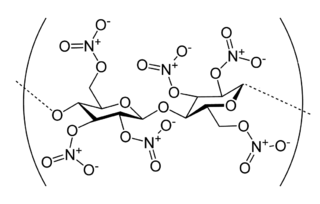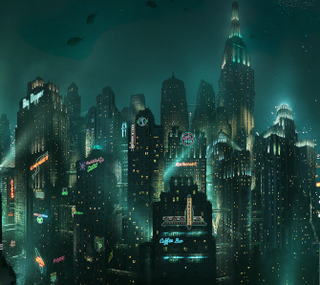Related Research Articles

Adhesive, also known as glue, cement, mucilage, or paste, is any non-metallic substance applied to one or both surfaces of two separate items that binds them together and resists their separation.

Acrylic paint is a fast-drying paint made of pigment suspended in acrylic polymer emulsion and plasticizers, silicone oils, defoamers, stabilizers, or metal soaps. Most acrylic paints are water-based, but become water-resistant when dry. Depending on how much the paint is diluted with water, or modified with acrylic gels, mediums, or pastes, the finished acrylic painting can resemble a watercolor, a gouache, or an oil painting, or it may have its own unique characteristics not attainable with other media.

Film stock is an analog medium that is used for recording motion pictures or animation. It is recorded on by a movie camera, developed, edited, and projected onto a screen using a movie projector. It is a strip or sheet of transparent plastic film base coated on one side with a gelatin emulsion containing microscopically small light-sensitive silver halide crystals. The sizes and other characteristics of the crystals determine the sensitivity, contrast and resolution of the film. The emulsion will gradually darken if left exposed to light, but the process is too slow and incomplete to be of any practical use. Instead, a very short exposure to the image formed by a camera lens is used to produce only a very slight chemical change, proportional to the amount of light absorbed by each crystal. This creates an invisible latent image in the emulsion, which can be chemically developed into a visible photograph. In addition to visible light, all films are sensitive to X-rays and high-energy particles. Most are at least slightly sensitive to invisible ultraviolet (UV) light. Some special-purpose films are sensitive into the infrared (IR) region of the spectrum.

Inhalants are a broad range of household and industrial chemicals whose volatile vapors or pressurized gases can be concentrated and breathed in via the nose or mouth to produce intoxication, in a manner not intended by the manufacturer. They are inhaled at room temperature through volatilization or from a pressurized container, and do not include drugs that are sniffed after burning or heating. For example, amyl nitrite (poppers), gasoline, nitrous oxide and toluene – a solvent widely used in contact cement, permanent markers, and certain types of glue – are considered inhalants, but smoking tobacco, cannabis, and crack cocaine are not, even though these drugs are inhaled as smoke or vapor.

Paint is a liquid pigment that, after applied to a solid material and allowed to dry, adds a film-like layer. As art, this is used to create an image, known as a painting. Paint can be made in many colors and types. Most paints are either oil-based or water-based, and each has distinct characteristics.

Screen printing is a printing technique where a mesh is used to transfer ink onto a substrate, except in areas made impermeable to the ink by a blocking stencil. A blade or squeegee is moved across the screen to fill the open mesh apertures with ink, and a reverse stroke then causes the screen to touch the substrate momentarily along a line of contact. This causes the ink to wet the substrate and be pulled out of the mesh apertures as the screen springs back after the blade has passed. One colour is printed at a time, so several screens can be used to produce a multi-coloured image or design.

Nitrocellulose is a highly flammable compound formed by nitrating cellulose through exposure to a mixture of nitric acid and sulfuric acid. One of its first major uses was as guncotton, a replacement for gunpowder as propellant in firearms. It was also used to replace gunpowder as a low-order explosive in mining and other applications. In the form of collodion it was also a critical component in an early photographic emulsion, the use of which revolutionized photography in the 1860s.

The organic compound 1,1,1-trichloroethane, also known as methyl chloroform and chlorothene, is a chloroalkane with the chemical formula CH3CCl3. It is an isomer of 1,1,2-trichloroethane. This colorless, sweet-smelling liquid was once produced industrially in large quantities for use as a solvent. It is regulated by the Montreal Protocol as an ozone-depleting substance and its use is being rapidly phased out.

Rubber cement is an adhesive made from elastic polymers mixed in a solvent such as acetone, hexane, heptane or toluene to keep it fluid enough to be used. This makes it part of the class of drying adhesives: as the solvents quickly evaporate, the rubber solidifies, forming a strong yet flexible bond.

A flatbed editor is a type of machine used to edit film for a motion picture.

An optical printer is a device consisting of one or more film projectors mechanically linked to a movie camera. It allows filmmakers to re-photograph one or more strips of film. The optical printer is used for making special effects for motion pictures, or for copying and restoring film material.
Negative cutting is the process of cutting motion picture negative to match precisely the final edit as specified by the film editor. Original camera negative (OCN) is cut with scissors and joined using a film splicer and film cement. Negative cutting is part of the post-production process and occurs after editing and prior to striking internegatives and release prints. The process of negative cutting has changed little since the beginning of cinema in the early 20th century. In the early 1980s computer software was first used to aid the cutting process. Kodak introduced barcode on motion picture negative in the mid-1990s. This enabled negative cutters to more easily track shots and identify film sections based on keykode.
A film base is a transparent substrate which acts as a support medium for the photosensitive emulsion that lies atop it. Despite the numerous layers and coatings associated with the emulsion layer, the base generally accounts for the vast majority of the thickness of any given film stock. Since the late 19th century, there have been three major types of film base in use: nitrate, acetate, and polyester.
A film splicer is a device which can be used to physically join lengths of photographic film. It is mostly used in film motion pictures. The units are made in various types depending on the usage: Single-8, Super 8 film, 16mm, 9,5 mm, 35mm and 70mm. Used in film editing to make a cut (transition).

Chipseal is a pavement surface treatment that combines one or more layer(s) of asphalt with one or more layer(s) of fine aggregate. In the United States, chipseals are typically used on rural roads carrying lower traffic volumes, and the process is often referred to as asphaltic surface treatment. This type of surface has a variety of other names including tar-seal or tarseal, tar and chip, sprayed sealsurface dressing, or simply seal.

Splicers is a role-playing game using the Palladium Books Megaversal gaming system. The game is set in the midst of a war between humans and a world-wide computer intelligence alternately referred to as the N.E.X.U.S. or the Machine. Players take on the roles of humans engaged in the fight against robotic, android, and necrotic minions of the Machine, using technology that is primarily derived from highly advanced biotechnology. The computer intelligence has released a "nanobot plague" on the world; within a few seconds of a human touching non-precious metal, the item will begin to twist and attack the person, sometimes even animating into a robotic minion of the Machine. The result is that the nanoplague has effectively made non-precious metal allergic to mammalian life.

Photographic film is a strip or sheet of transparent film base coated on one side with a gelatin emulsion containing microscopically small light-sensitive silver halide crystals. The sizes and other characteristics of the crystals determine the sensitivity, contrast, and resolution of the film. Film is typically segmented in frames, that give rise to separate photographs.

Rapture is a fictional city-state in the BioShock series published by 2K Games. It is an underwater city that is the main setting for the games BioShock and BioShock 2. The city also briefly appears in BioShock Infinite, and is featured in its downloadable content, Burial at Sea. The game's back-story describes the city as envisioned by business tycoon Andrew Ryan in the mid-late 1940s as a means to create a utopia for mankind's greatest artists and thinkers to prosper in a laissez-faire environment outside of increasing oppression by the world's governments and religion. However, the lack of government led to severe wealth disparity, a powerful black market, and unrestricted genetic modification, which turned the city into a dystopia exacerbated by Ryan's tyrannical methods to maintain control. The masses turned towards political activists like Atlas who advocated an uprising of the poor against Ryan and the elite of Rapture; and on the eve of 1959, a civil war broke out, leaving much of Rapture's population dead. The remaining citizens either became psychotic "Splicers" due to the effects of ADAM, a substance that can alter genetic material, or have barricaded themselves from the Splicers to protect themselves, leaving the city to fail and fall apart around them.
Waterborne resins are sometimes called water-based resins. They are resins or polymeric resins that use water as the carrying medium as opposed to solvent or solvent-less. Resins are used in the production of coatings, adhesives, sealants, elastomers and composite materials. When the phrase waterborne resin is used, it usually describes all resins which have water as the main carrying solvent. The resin could be water-soluble, water reducible or water dispersed.
References
- ↑ "City Net, The Art for Film Splicing". Archived from the original on 2013-04-02. Retrieved 2013-02-17.
- ↑ The National Film and Sound Archive of Australia, film cement
- ↑ The National Film and Sound Archive of Australia, film splicers, cement and tape
- ↑ "City Net, DEMONSTRATION SPLICER page". Archived from the original on 2013-04-02. Retrieved 2013-02-17.
- ↑ The National Film and Sound Archive of Australia, emulsion
- ↑ Roxy Theater, projector for release print
- ↑ "City Net, Making consistently good, clean splices". Archived from the original on 2013-04-02. Retrieved 2013-02-17.